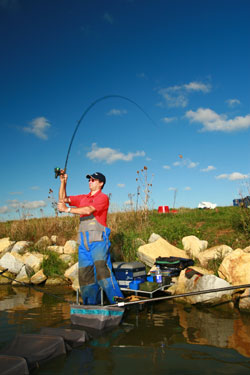Gareth Purnell, TCF editor, gets out his braid as he goes in search of a bag of Ferry Meadows bream and skimmers.
My first brush with Ferry Meadows Lake near Peterborough was probably 15 years ago. Back then, working on Angling Times, we had an annual challenge and that’s how I got to know the venue’s bream and skimmer population.
I’ve generally done well there. I love fishing big, open, natural waterways which are often windswept and, in truth, I would rather catch a nice bag of bream than ton-up on carp on a commercial water.
To do well with bream you need to understand how they behave. I’ve fished all over Europe and can tell you that English bream are the same as those on the Continent. They are browsers, very rarely aggressive and tend to back away from any noise or disturbance, especially if it’s sustained.
One thing that’s unusual about English bream, though, is the taste they have developed for fishmeal. Saying that, I’m prepared to bet that bream in French waters frequented by carp anglers go mad for pellets, too.
But in countries where the carp fishing boom hasn’t kicked in, bream don’t respond to fishmeal. It does seem quite odd that bream and skimmers in natural waters love pellets so much. You can understand it on commercial fishery and syndicate carp waters where so much bait goes in. But, like many natural waters, Ferry Meadows sees its share of carpers, and the bream and skimmers have lapped it up.
When I’m fishing waters like Ferry Meadows I use fishmeal in both groundbait and pellet form. As you’ll see from the sequence, much Crazy Bait Gold goes in my groundbait mix, but any of your favourite fishmeals will do the job as long as it’s fine.
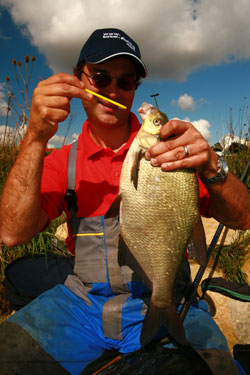 |
| Gareth Purnell with a typical Ferry Meadows bream. |
The bream love eating the groundbait, but it won’t hold many fish over a long period, so I add quite a lot of sinking micro pellets, which I soften by soaking in water for a couple of minutes before draining.
These are then kept separately in a bait tub rather than added to the groundbait. I’ll look to feed at least 10 large feederfuls of pellets blocked either end with the groundbait mix before I start fishing, plus whatever I’m using on the hook.
Today I’m fishing Peg 92 on Gunwade Lake, close to a point known as The Monument. There’s a buoy out in front of me and a cast of around 40 yards places me just short of that. Some good advice here is to err on the side of caution when choosing how far out to fish. If you can comfortably reach 45 yards, fish at 40. That way if the wind gets up you won’t find yourself unable to reach your feed area, and it allows you to fish beyond your feed, more of which later.
I’ve clipped up just short of 40 yards. It’s a long time since I’ve fished these pegs and I’m surprised to find it quite shallow out there – only around four feet deep. Two weeks ago, located about 20 pegs to my left, I finished second in a match where it was twice the depth.
But there’s a breeze on the water creating a ripple, and I’m quite confident I should be able to persuade a few fish to feed.
Unless I’m fishing in very cold conditions I’ll always put out a bed of food before I start fishing. For this I use as big a feeder as I can cast to the clipped-up distance, and a good tip is to do this before you add your hooklength to prevent yourself getting into unnecessary tangles.
Once I’ve thrown out some pellets the next job is to put some of my hook bait options out there and get the fish feeding. Today I’m expecting to catch some skimmers on maggots with the possibility of catching ‘proper’ bream on worms later. So, to get the fish used to eating little wriggly things, I’m putting a few squatts into the groundbait mix and have chopped up a big handful of medium-sized dendras which I bulk out with a decent scoop of casters – another great holding bait.
Once again this is fed to the clip by sandwiching the chopped worm and casters between the fishmeal groundbait either end of a large Nisa Flyer feeder. These have a tapered lead along one side and are, in my opinion, the number one feeder for medium- to long-range bream fishing.
It’s taken me a full 15 minutes to put in all the feed. I’m pleasure fishing today but I’d even spend the time doing this in a five-hour match.
To understand why it’s important you have to think about the way bream react. They will certainly have backed off from my feed for the moment, but now I’m going to switch to a smaller Nisa Flyer feeder, which makes far less disturbance on entering the water. With luck, now that the major disturbance has died down, the fish will slowly and carefully, but surely, start to move toward the bed of bait. One thing we can be sure of is that the fish will want to feed, as long as we don’t put them off doing so by continually banging a huge feeder on their heads.
Now we can put on the 20-inch hooklength – which I’ve already tied and is nicked into my keepnet – and we’re ready to fish.
Well, almost. For my next trick I’m going to cast out an empty feeder away from the feed area and unclip the braid from the line clip on the spool. Madness? Not really. Before I do this I’ve marked the braid above the clip with a permanent black marker pen so I can easily return, at any time, to the exact spot at which my feed sits.
The reason for unclipping is that I want to start by fishing beyond my feed, to where I feel the fish may have backed off. So I pull off about four arms’ lengths of braid and then clip up again.
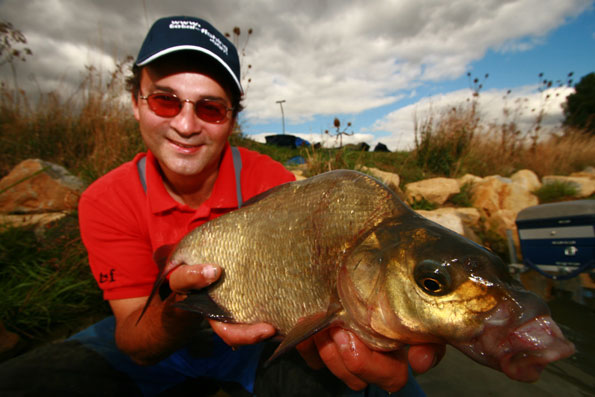 |
| On the day the bigger fish fell to a large piece of worm. |
The idea is that I’ll gradually move back to the main baited area and, by doing so, the trail of bait I create should help tempt a few fish to follow the chopped worm and caster I leave on the bottom.
Incidentally, I’m also using today’s session as an opportunity to experiment, and not just with various braids (see panel).
Normally when I’m fishing with braid I use a length of around 20ft of 4-5lb mono as a shockleader at the end of it. The stretch in this shockleader helps on the cast but, more importantly, results in fewer hook pulls on the soft-mouthed skimmers than if you fished braid straight through.
But it does have its downfalls. The shockleader is tied to the braid using a four-turn water knot; it’s important to leave the tag ends of both at least an inch long so they remain supple and will fly okay through the tip ring on my Preston Innovations 11ft 6in CarbonActive Feeder. But, sooner or later, the knot will catch in the rings and this often results in cracking off. I have seen anglers use varnish to smooth off the knot to reduce this, but haven’t yet come across a foolproof solution.
Today is giving me the opportunity to try one of the ready-made feeder bungees. The great thing about this is that the stretch in the bungee means there’s no need for a mono shockleader (so no chance of cracking off). I’ve simply tied the braid to the end of the bungee using a grinner knot.
First impressions are good. I’ve now got 100 per cent confidence I won’t crack off, and I’m casting accurately with great confidence. The problem is that although I’m getting bites, they are very ‘iffy’ indeed. I’m getting taps on the quivertip but the fish are dropping the bait.
I change down from a size 16 B611 hook and 0.12mm hooklength to a size 20 and 0.11mm with single red maggot on the hook, and that buys me a couple of decent skimmers along with the odd stray bleak from the nearby River Nene. But I have to really play the skimmers with kid gloves and can’t help thinking I’m fishing too light to hook any bream of a larger size.
I fish with the bungee for an hour and pick up a couple more skimmers, but I’m convinced the fish are feeling the extra weight of the swivel on the bungee as well as the bungee itself. I need a more sensitive approach, and so reel in and set up with a shockleader, with the feeder fished on an eight-inch loop.
The difference is startling, the first three casts with the new set-up producing a skimmer immediately. With the line simply pulling through the tip of the clip swivel attaching the feeder on the loop, there’s nothing untoward for the fish to worry about, and they’re holding onto the bait long enough for me to hit the bites.
That gives me the confidence that there are indeed plenty of fish around. I change back to the size 16 with the heavier hooklength and a very wriggly 2.5-inch worm on the hook. I believe that the movement of a worm can sometimes cause bigger fish to have a go even if they’re unsure – they can’t help themselves!
I’m fishing right over my pre-baited area now and I have to wait a bit longer for a bite this time. But when it does come it’s a dramatic pull round and I feel the satisfying thud of a decent bream on the end.
The water in front of me is very shallow and when I get the fish in close it goes bonkers – I’m glad I’ve got the heavier line – and soon a 3lb bream is in the bag.
The session goes well from there, with a string of skimmers and the best bream at maybe 4lb 8oz. Whenever the bites dry up I put on the bigger feeder for a couple of casts, so as to offer more bait, and then swap back to the smaller one when I’m confident there are a few fish knocking around.
The big piece of worm has been the key today. If I offer a maggot I get a very small skimmer or sometimes a bleak. The other big thing I’ve learnt is that when skimmers are my target, I won’t be using a bungee again!
tcf Top Tip
Gareth uses as big a feeder as will comfortably reach the required distance (left) for the 10 to15-minute feeding period at the start of the session; he puts in plenty of pellets, chopped worms and casters blocked either end with a fishmeal-strong groundbait. This is done before he attaches a hooklength. Once he starts fishing on goes a smaller Nisa Flyer (right), and he’ll only switch back to the big feeder for a few casts if the bites die off later in the session.
Rods For The Job
Rod choice is critical when fishing with braid – you need a rod with a through action in the top half which will soak up the sharp ‘bangs’ and lunges that are transmitted as a hooked fish shakes its head or dives. This kind of soft action thus prevents the kind of hook pulls that are commonplace with a rod that’s too stiff. But the rod does need some backbone lower down to cast a fully-laden feeder any decent distance. My favourite for this kind of work is the Preston Innovations 11ft 6in CarbonActive Feeder, a three-piece rod which comes with three full tip sections. It laps up the job as long as you aren’t trying to cast over 50 yards.
Fishing With Braid
Braid is absolutely vital as your main line at Ferry Meadows. The skimmers, in particular, are very shy biters and the lack of stretch in the braid means you can easily detect bites which simply are not visible when fishing with mono.
If you were only catching big bream you could probably get away with mono because the bites from the bigger fish tend to be more aggressive. But normally you’ll mainly catch skimmers in the 3oz to 1lb 4oz bracket and so you’ll need braid.
If asked to recommend one braid for feeder fishing it would be Berkley Fireline in the 4lb breaking strain. But today I’m putting three other braids through their paces, fishing each for an hour with the Drennan Feederbraid, Shimano Antares and Ultimate Power Braid. The key is how quickly they sink, and thus how quickly I’m effectively fishing. Following the session I can reveal that the Drennan is the best by far.
Braid Tips
The 4lb mono shockleader is attached to the braid using a four-turn water knot.
Leave the tag ends about an inch-and-a-half long – this way the knot goes through the rod rings more easily.
You need enough mono so that when you’re about to cast there are around five turns on the spool.
Gareth marked the distance he fed with a black marker pen because he started fishing beyond his feed.
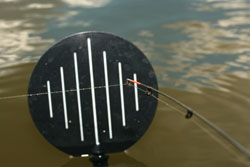 |
Hitting Your Bites
The bites you get when braid fishing are magnified due to the lack of stretch in the ‘line’. They can be quite dramatic, but even with braid skimmers may only give small movements on the tip and a target board will help you identify these. The main lesson is that you should never strike when braid fishing or you’ll just rip the hook out of the fish’s mouth. Instead, just pick up the rod and start to wind, and if you’ve timed things right the fish will be on.
Gareth’s Bream Mix
Step 1
The raw materials are based around fishmeal, brown crumb and a slightly more active groundbait like Sensas Lake.
Step 2
It’s about 60 per cent Crazy Bait Gold with the rest equally made up of the crumb and the groundbait.
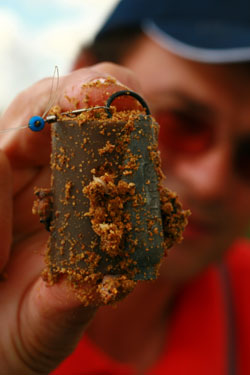 |
| Crumb and Sensas Lake with a bit of fishmeal is Gareth’s favoured bream mix. |
Step 3
The dry ingredients are first thoroughly mixed together.
Step 4
Gareth pushes some Tracix through a fine sieve and mixes the groundbait with the water to create a cloud.
Step 5
A sweet bream additive is also added to the water – liquid in summer, powder in winter.
Step 6
You can see how oily this Dynamite stuff is – but the groundbait will soak up all those oils and slowly release them.
Step 7
Gradually add the cloudy, sweet liquid to the dry groundbait, mixing as you do so.
Step 8
Keep adding water and mixing until you can squeeze a ball one-handed…
Step 9
… so it crumbles easily into fine particles.
Step 10
The mix is now pushed through a pinkie riddle to remove any lumps.
Step 11
The finished mix is fine and crumbly but will hold the feed in the open-ended feeder.
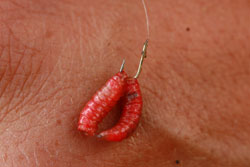 |
Bait Tips
Gareth added a few squatts to the groundbait because he planned to fish maggot for the skimmers.
Overfill your caster bait tub with water at the start so you can scoop away any that float.
When fishing double maggot, hook the second one upside down as this will prevent line spin.
The Pellet Revolution
Even on natural waterways like Ferry Meadows the bream population has switched onto pellets, so sinking micro pellets are an important addition to Gareth’s attack. The pellets are soaked in lake water for a couple of minutes to soften them before draining off the water. Keep the pellets in a separate bait tub rather than simply mixing them in with the groundbait as doing this can alter the mix’s consistency.
tcf Top Tip
When fishing chopped worms, adding some water to the tub in which they’re kept makes it much easier to work the scissors through them than trying to cut them up when dry.


